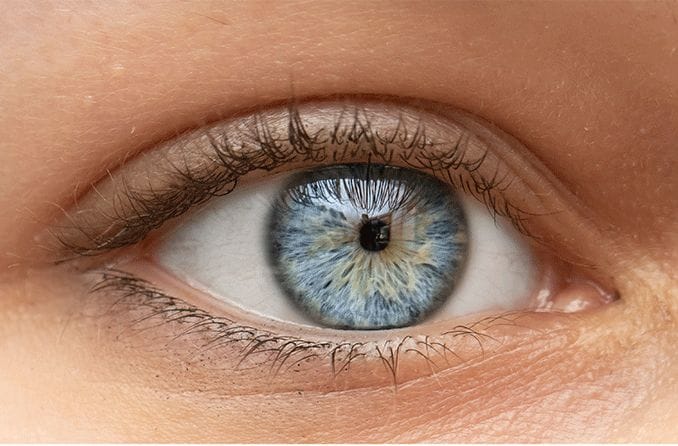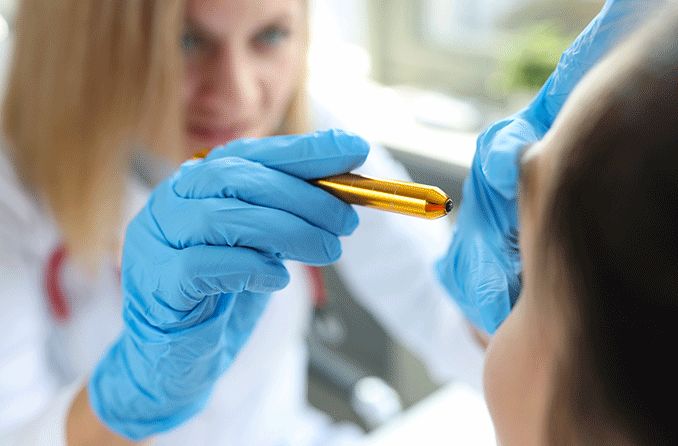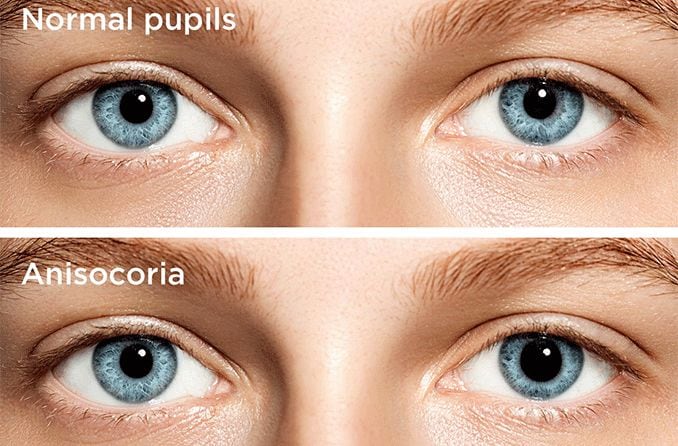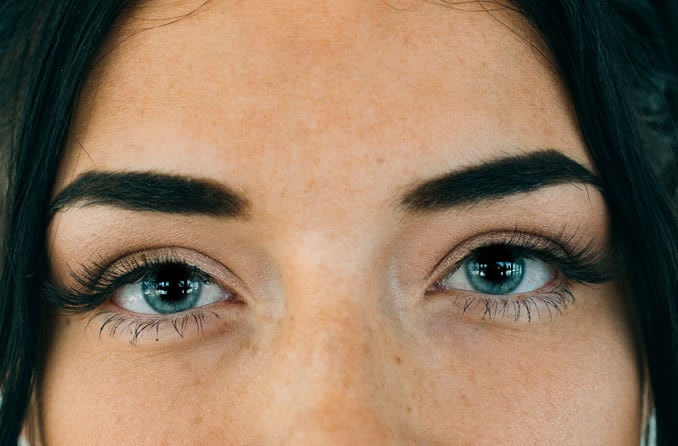What’s the difference between a “normal” pupil and a small pupil?
The pupil is the opening in the center of the colored part of the eye (iris). Pupils naturally get larger and smaller thousands of times a day, regulating the amount of light that enters the eye. This light is focused on the retina to allow eyesight.
Abnormally constricted pupils (miosis), also known as pinpoint pupils, may be a sign of a larger issue with your health. With miosis, one or both pupils consistently measure less than two millimeters across.
While your pupils normally open (dilate) in low light and grow smaller (constrict) in bright light, they also naturally get smaller as you age — this is not a sign for concern.
But, knowing more about whether your small pupils are normal or indicate a problem is key to understanding if you’ll need medical attention.
Are my small pupils normal?
Average sized pupils generally range from two to eight millimeters. This size varies based on the amount of light in the environment:
- Bright light – Pupils normally constrict to between two and four millimeters in size.
- Low light – Pupils normally dilate to between four and eight millimeters in size.
Pupils also typically get smaller when focusing on nearby objects and grow larger when focusing on faraway objects.
Both pupils may be the same size, but some people have pupils of different sizes (anisocoria). This condition may be perfectly normal. In some cases, however, anisocoria can be a sign of a serious problem, such as a viral infection, an issue with the nervous system or an eye injury or condition.
Aging and pupil size
Pupil size changes naturally with age — this is totally normal. In newborns, for instance, pupil size is much smaller, though size increases as a child grows, becoming largest in adolescence. During the teen years and throughout adult life, pupils shrink.
In older adults, pupils are smaller when at rest in the dark and slower to dilate in response to light.
One study measured pupil size at different light levels and across different age groups. The results show that, in the right eye, average pupil size ranges from 2.41 to 5.80 millimeters in people ages 15 to 30 and from 2.38 to 4.52 millimeters in those over 60 years of age.
SEE RELATED: How vision changes as you age
What causes a constricted pupil?
A variety of conditions and health issues ranging from eye injury to drug use can result in an abnormally constricted pupil.
Typically, pinpoint pupils are caused by:
- Certain conditions, including Adie’s tonic pupil (also called Adie’s pupil and Adie’s syndrome)
- Injury to the eye or brain, such as a concussion
- The use of some types of prescription or illicit drugs
- A serious medical condition, such as a stroke
It’s important to note that overly dilated pupils — the opposite of small, constricted pupils — can also be problematic and may point to a medical cause that needs to be addressed.
Conditions that can cause small pupils
Small pupils may mean that you have an underlying condition. Some of the conditions that can cause constricted pupils include:
- Cluster headaches – Cluster headaches are a rare type of neurovascular head pain. Eye-related symptoms may include miosis, eyelid swelling and conjunctivitis (pink eye) on the same side as the pain.
- Horner’s syndrome – Symptoms of Horner’s syndrome typically affect one side of the face, and include a constricted pupil, a drooping eyelid and an inability to sweat. This rare disorder can be congenital or may be caused by trauma, a brain tumor or even an insect bite that affects eye nerves.
- Inflammation of the iris (iritis) – Inflammation of the colored part of your eye can lead to abnormally small or oddly shaped pupils as well as other symptoms (blurry vision, eye pain, red eyes, etc.). Iritis may be the result of an autoimmune disorder, trauma or a bacterial or viral illness, such as herpes simplex, Lyme disease or HIV/AIDS.
- Stroke – Strokes that involve the brain stem may cause abnormally constricted pupils or dilated pupils. Other symptoms of brainstem stroke may include diplopia (double vision), dizziness, severe balance problems and slurred speech.
- Syphilis – Late-stage syphilis can cause a condition known as Argyll Robertson pupil, with two abnormally tiny pupils that do not respond (or respond slowly) to light but constrict when the eyes focus on a nearby object. This happens when the bacteria that cause syphilis gets into the cerebrospinal fluid (CSF).
Other conditions and diseases can also cause constricted pupils. If you’re experiencing a medical emergency, it’s important to seek medical care immediately.
Small pupils after a concussion
Concussions are traumatic brain injuries caused by a hard blow to the head that can affect the size of the pupils. In fact, pupil size may be one of the signs of a serious brain injury that requires emergency medical help.
People who have experienced head trauma from an auto accident, a fall or a sports injury should seek medical care right away if there is a change in pupil size, such as one tiny pupil.
Other eye-related symptoms after a concussion can include blurry vision, photophobia (light sensitivity) and seeing flashing lights that may look like stars.
Small pupils caused by medication
Some medications can cause constricted pupils, including prescription drugs used for pain management (codeine, morphine, etc.) or for the treatment of health conditions, such as anxiety or hyperactivity.
Substances that may be causing your small pupils include:
- Antihistamines – These drugs are commonly used to treat allergies. Some first-generation antihistamines, such as diphenhydramine, may cause miosis as a result of their sedative effects.
- Atypical antipsychotics – Atypical antipsychotic drugs are used to treat mental health conditions such as bipolar disorder, depression and schizophrenia. They include aripiprazole (Abilify), clozapine (Clozaril), paliperidone (Invega) and quetiapine (Seroquel).
- Barbiturates – Barbiturates are depressants that may be prescribed for anxiety, sleep, muscle spasms or seizures and can also be abused. Barbiturates include: amobarbital, pentobarbital, phenobarbital and secobarbital.
- Cholinergic drugs – Such medications affect a neurotransmitter in the parasympathetic nervous system. They may be prescribed for a variety of conditions, including glaucoma and dementia.
- Clonidine – This drug is used to control high blood pressure or, in extended release form, to treat attention deficit hyperactivity disorder (ADHD) in children.
- Opioids – The opioid class of medications includes prescription drugs for pain management (codeine, fentanyl, hydrocodone, oxycodone, morphine, etc.) as well as the illegal narcotic heroin.
With substances that normally cause dilated pupils, having constricted pupils instead may be a sign of a drug overdose. Concerned parents may want to keep an eye out for signs of drug use, including tiny pupils or dilated pupils.
When to see a doctor for small pupils
Small pupils can be a sign of a serious medical problem, especially when accompanied by other symptoms. Get urgent medical attention if:
- You experience small pupils with dizziness and/or balance issues.
- You suffer a head injury and notice one or both pupils seem abnormally small.
- You have small pupils along with eye pain, vision changes or any other concerning symptom.
It’s also important to get regular eye exams to detect any issues as soon as possible.
Your eye doctor will check your pupils during a routine eye exam. (For example, your eye doctor may perform the “swinging flashlight test” by shining a flashlight in your eye to see how your pupils react.) Regular eye exams play a key role in keeping your eyes healthy.
READ NEXT: What is a blown pupil?








